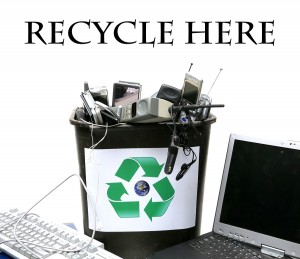Computers and electronic equipment are made of a variety of plastics, metals, glass and precious metals. When recycling electronics, we aim to separate different materials from one another. The “products” we produce from recycling are recycled plastics, clean streams of iron, steel, copper, aluminum, glass and precious metals. The better we separate the ingredients, the more ways these items can be used to create the next generation of products.
Electronic equipment may contain heavy metals and other materials that may be hazardous to human health and the environment. Computers and electronic devices generally include :
- LED – Computer monitors have a picture tube known as a cathode ray tube (CRT). CRT contains leaded glass, and is the largest source of lead in municipal waste. The solder used in printed circuit boards may also contain lead.
- Cadmium – The largest source of cadmium in municipal waste is rechargeable nickel-cadmium (NiCd) batteries. These batteries are mostly found in desktop and laptop computers.
- Mercury – Some electronic devices also contain recoverable amounts of mercury, which is a toxic metal.
US The Environmental Protection Agency (EPA) treats some discarded electronic equipment as specific hazardous waste under the Resource Conservation and Recovery Act.
How are computers recycled ?
Process 1 – Receiving and Pre-processing
We procure, sort and process computer equipment from businesses based on client specific requirements. The customer reports we are able to produce depend on how the equipment is handled before it is recycled.
- Reporting by weight
If the unit of measurement for a customer report is by weight, pre-processing will include weighing shipments as they are received and manually removing dangerous goods (such as batteries). When necessary, equipment can be sorted by type or material to facilitate more detailed customer reporting by weight.
- Reporting by item
Some customers require reporting by item rather than by weight. In this case, in addition to weighing the shipment, each item received will be scanned and audited according to the requirements of the client. Data of data bearing objects are destroyed before recycling.
Process 2 – Risk Removal
Once the equipment is received, the next step in computer recycling is to remove and separate the hazardous material from the monitor, including batteries, toner/ink, mercury bulbs found in some scanners/printers, and cathode ray tubes, which contain lead. it happens. to do this. This manual process ensures that hazards are dealt with in a friendly manner and is vital in providing eco-friendly solutions.
Process 3 – Clipping
Our major recycling sites are equipped with automated industrial shredders, conveyor systems and sorting equipment. After the hazards are removed, the computer equipment is fed by a conveyor to a large shredder. The shredder shreds the material into large pieces, about 2” to 6” in diameter. This first step creates e-waste to begin the process of separating plastic parts from steel, copper, aluminum, glass and other objects.
Adjacent human support services include management of hard drive destruction, parts recovery, property repair and resale, and safe disposal of hazardous waste.
Process 4 – Sorting of Objects
After shredding, conveyor belts push the e-waste through magnets, eddy currents, infrared cameras, and air jets. These technologies sort and separate different types of material from the e-waste stream.
Iron and steel are separated from the e-waste, then aluminum, copper and circuit boards are separated. After the bulk metal is removed, the e-waste stream, which is now predominantly plastic, is separated from polystyrene plastic into ABS. In the final stage, the plastic is sent through an advanced metal removal process to remove any residual metal and improve the purity of the plastic stream.
Process 5 – Collection and shipment of personal items
As each item is segregated from the e-waste stream, the material is collected in pallet sacks or large cardboard boxes and shipped to another processor or directly to the manufacturer. Using recycled materials in the manufacture of new products has benefits that go far beyond simply reusing the material. This reduces pollution and carbon emissions, reduces energy and water consumption, and keeps useful materials out of landfills.
SLS has earned the reputation of producing high quality recyclable products from our facilities. Manufacturers and secondary processors want to help us use our recycled items.
What are the benefits of recycling computers and electronics ?
Recycling and reusing electronic equipment reduces the amount of hazardous materials entering the environment. Recycling and reuse programs also reduce the amount of electronic scrap being landfilled in the state.
Computers in Mississippi are being updated by programs installed in the state. The refurbished computers are then placed in classrooms across the state where they benefit children and help augment the school budget for other essentials. Some computer refurbishing programs also provide computers to individuals and non-profit organizations that cannot afford to purchase new computers.
The process by which computers and other electronic equipment are refurbished or broken down into their original parts is called manufacturing. This helps conserve energy and raw materials needed to manufacture new computers and electronic devices. These parts are then reused to upgrade other computers.
Computer upgrade programs have proven to be an excellent work force training tool for correctional facilities, young adults and people with mental and physical disabilities. The Correctional Facility Program trains prisoners with computer skills that should help them find jobs upon release.

